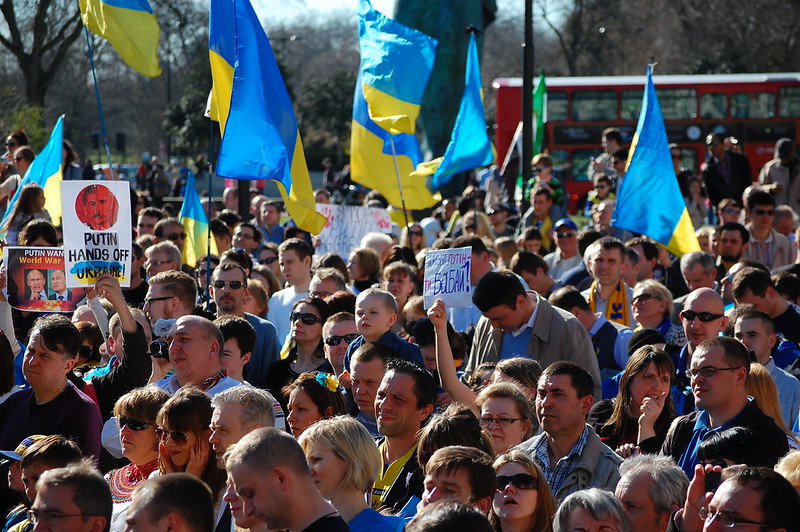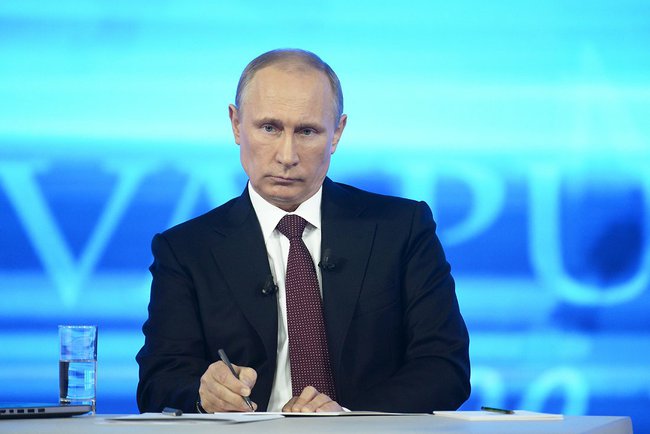
Chilling parallels can be drawn between Russia’s current build up on Ukraine’s eastern border and the invasion of Crimea in 2014. US intelligence observations assert that as many as 175,000 Russian troops could be mobilised along the Russo-Ukrainian border in January, a strategic move that Western analysts have correlated with President Vladimir Putin’s exponential use of bellicose rhetoric. In April 2021, in his state of the nation speech, Putin explicitly warned against the West crossing Russia’s “red lines”, threatening Moscow would respond decisively to any provocations – “if someone mistakes our good intentions for indifferences or weakness and intends to burn down bridges, they should know that Russia’s response will be asymmetrical, swift, and harsh”. In response and continuing the high risk discourse, the US Senate Foreign Relations Committee proposed a legislative amendment that could see strict new financial sanctions levied against Moscow. Any further encroachment on Ukrainian sovereignty would therefore trigger crippling financial damage to companies like Russian conglomerate Gazprom and banks, drying up investment and production in the energy sector and causing significant international risks.
In the midst of volatile, escalating diplomatic tensions, it is no surprise the ruble and the Russian stock market have stumbled as a possible military confrontation between Russia and Ukraine looms over investors’ cost-benefit calculations. The RTS Index –Russia’s main stock market– faced a 4% downturn at the end of November and the Russian ruble lost 1.1% value against the US dollar. Banks were amongst the most compromised and vulnerable to these risks, perceived as vulnerable to a devaluation in the ruble and escalating Western sanctions. These downturns emerged after a period of relative calm in Russia’s diplomatic relations with the United States, following the Geneva Summit between Putin and President Joe Biden in June. With the déjà vu that current geopolitical tensions recall, investors and businesses are justified in exercising caution. However, their caution and concern should not be grounded on an assumed high likelihood of an invasion of Ukraine, but rather, on the chronic –and mutual– misunderstandings of Russian and Western foreign policy objectives that have created a fragile balance of power in Eastern Europe.
Why Russia will likely invade Ukraine
In the face of uncertainty, seeking refuge in numbers and statistics can often grant a feeling of objective clarity for analysts. Russo-Ukrainian geopolitical tensions are no exception to this. According to military analysts and experts, an invading force needs to be three times bigger than the defending force. If US intelligence predictions are correct and if 175,000 Russian troops were mobilized to the Ukrainian border by this month, the likelihood of success would be marginal at best in the case of an invasion. After all, Ukraine has the third largest army in Europe, amounting to 280,000 troops, in addition to a lucrative and technologically advanced arsenal of weapons supplied by the United States and Turkey.
Undoubtedly –and unfortunately–, these calculations represent a best case scenario when assessing the international risk landscape. Couldn’t Russia simply unleash its 1 million ground troops in all their might, as the fifth largest army in the world? And why would every single unit of the Ukrainian army choose to mobilize to defend its Eastern territory? The volatility of Eastern Europe’s balance of power makes it impossible to pair answers to these questions with infallible certainty, however, the developments of the last eight years offer some marginally optimistic answers.
Russia’s full mobilization –or at least to a degree that tips the 3:1 scale in its favor– would require a demobilization of personnel away from Central Asia, the Caucuses, and the Chinese border, offering more costs than benefits to Putin. “[He] is a very angry leader because he knows that Russia of the BRIC countries is a declining power, they have an inferiority complex,” notes Taras Kuzio, British academic and expert in Ukrainian affairs in conversation with The International Risk Podcast. Despite Putin’s often irrational behavior, a substantive mobilization with a final purpose of invasion or occupation would only open pores throughout its borders, hurting national security initiatives like those against separatists in the Northern Caucasus. The recent withdrawal of 10,000 troops away from the Ukrainian border following the completion of drills back to their permanent bases is a precise indication of the high costs of demobilizing soldiers away from key posts, but far from confirmation that Russia will not invade Ukraine.
“One of the major risk aspects of this is that the Russian leaders live in a world which has little to do with reality” argues Kuzio. This is particularly true when understanding how Ukranians view Russia has been shaped since the war in Crimea. “Today, the people who have suffered the most from the war are Russian speakers because of the war in Eastern Ukraine… ironically, the people that Putin is claiming to protect and defend are the ones that are suffering the most from his actions”. With this recent historic memory in mind and adding the 460,000 veterans from the Crimea War, the construction of a ‘Russian brotherhood’ across the Russo-Ukrainian border is a poorly constructed fantasy and would be grounds upon which a full Ukrainian mobilization would be likely.
Europe’s Gas Station – Russia’s Leverage over Europe?

Not everything in modern conflicts comes down to militaries, however. The elephant in the room whenever discussing Russo-Ukrainian political tensions is Nord Stream 2, often cited as a dormant source of Russian energy blackmail. Russia currently supplies more than a third of Europe’s gas supplies through the existing Nord Stream pipelines that run through Ukraine, which reaps about 4% of its GDP in transit fees. Despite being marketed as a purely commercial venture by Germany and Russia, Nord Stream 2 if completed and approved, would change the game board and isolate Ukraine in the process. When fully operational, the pipeline would ship about 55bn cubic metres of gas to Germany every year, amounting to about 15% of the EU’s annual gas imports. The argument goes that Russia could turn the gas tap off, rack up energy prices in Europe, and manipulate the West into giving Moscow a green light to secure its sphere of influence in Ukraine.
Due to the financial gains Moscow would attain from Nord Stream 2 plus its geopolitical value, the pipeline has been at the heart of potential sanctions against Russia. Jake Sullivan, US National Security adviser warned that “if Vladimir Putin wants to see gas flow through that pipeline, he may not want to take the risk of invading Ukraine”. However, its blackmailing power has been thoroughly hyperbolized.
Nord Stream 2, upon completion, would be subject to Brussels legislation designed to promote competition in a free market, which would force Gazprom to abide by a process of unbundling. As different companies produce, transport, and distribute gas within the EU, Gazprom’s monopoly over gas in Europe –and consequently Russia’s– would be diluted. Nord Stream 2 would also need to be accessible to third-party access and have non-discriminatory and transparent pricing structure. Germany is yet to approve the completion of the pipeline, and considering the bureaucratic hurdles yet to be jumped and the need to convince the Green Party of the coalition government to support the project, Putin will need to wait longer to indulge in the satisfaction of an operational pipeline that avoids Ukrainian grounds. Anxieties of blackmail and a carte blanche on further incursions into Ukraine rest on the assumption of a fully constructed Nord Stream 2, which currently, does not appear to be within reach.
Angry Leadership and the Ghost of the Cold War

Although strategic, military and economic interests all are quantified as ingredients of a risk assessment function, Western analyses of Russia’s intentions have been handicapped by excluding the importance of national identity and ideology. “It’s nothing to do with NATO enlargement, it’s down to the question that for Vladimir Putin and similar Russian nationalists, Ukraine is a Russian land and Ukranians are one of three branches of the Russian people,” reveals Kuzio. If identity truly is at the heart of the matter, the implication is that uncertainty and risk will remain as major foreign policy decisions could come down to the irrational whims of Putin, who in many ways, is invoking Cold War mentalities to guide his strategic decisions.
“What Putin really wants is a second Yalta agreement” argues Kuzio. In other words, a geopolitical game where Russia and the United States –just like Churchill, Roosevelt, and Stalin– play God over Europe and distribute the former Soviet Union territories into an undisputed Russian sphere of influence. In Russian eyes, Ukranians have been ruled against their will by Volodymyr Zelensky since the Euromaidan Revolution of 2014, who allegedly has ruled the country as a puppet of the United States. Therefore, pressure on Ukraine now is not only a defensive proxy conflict against the West but also a crusade of sorts that seeks to unite all Russian peoples.
However, as Kuzio tells The International Risk Podcast, “the days are gone when big powers can decide the fortunes of small countries”. Russian demands inevitably corner the geopolitical order in Eastern Europe into tight gridlock as the United States will be unable to give Moscow the security guarantees it is demanding over its desired sphere of influence– diplomacy will simply be a formality that is unlikely to satiate the needs of either side.
These sorts of demands, as irrational and far-fetched as they may sound to Western analysts, are not going to go away. De facto, Putin became President for life following the changes to the Constitution in July of 2000 and his ultra-nationalism has only continued to overpower his foreign policy guidebook and erode the rule of law. As the volatility of the Eastern European balance of power increasingly mirrors Putin’s individual preferences, businesses should continue to tread on the side of caution and have a robust set of risk indicators that help business leaders monitor the international risk environment.
Pingback: INTERNATIONAL RISK OUTLOOK FOR 2022 – The International Risk Podcast